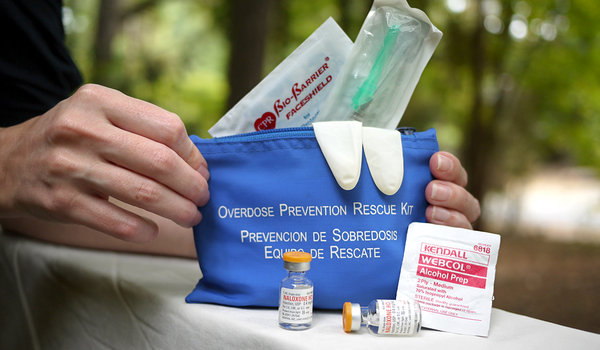North Olympic Peninsula counties are expected to start offering naloxone injection kits to heroin addicts and their families this year through syringe exchange programs.
The life-saving strategy could start as early as this summer in Clallam County, and Jefferson County could have a similar program in place by fall.
Naloxone, an antidote to opiate drugs, already is carried by Port Angeles police officers and Jefferson County emergency medical technicians.
It can counteract an overdose quickly and sufficiently for a drug abuser to receive necessary medical treatment.
The Clallam County Board of Health at its April monthly meeting had delayed distributing naloxone while it made sure county employees could be shielded from liability for dispensing the antidote.
However, Gov. Jay Inslee signed House Bill 1671 on
May 8 to grant “Good Samaritan” protection starting July 24 to people who administer the drug in good faith.
The Board of Health voted unanimously last Tuesday to approve distributing naloxone through its Syringe Services Program in which drug abusers exchange dirty needles for sterile ones.
Jefferson County is examining its policy options and costs, said Jean Baldwin, county public health director.
“We’re exploring with our Board of Health how much does it cost, how much should we assume as the Board of Health, and should we pursue outside funding,” Baldwin told the Peninsula Daily News.
“We have to set the policy piece — and Clallam is ahead of us there — but we should have this by fall.”
An average 600 people died of unintentional heroin overdoses in Washington in the years 2009-2011, according to the University of Washington.
Opiates are drugs naturally derived from opium or synthetically produced to have the same narcotic, painkilling effects.
In Clallam County, according to figures for 2011-2013 from the university, fatal opiate overdoses totaled about 15 per 100,000 people, or around 11 to 16 deaths per year.
In Jefferson County, the rate was about 11 per 100,000 people, or roughly three deaths per year.
“This is a crisis of our time,” said Clallam County health board member Bryon Monohon, who is also mayor of Forks, at last Tuesday’s meeting.
People who receive the kits that include two doses of naloxone — also known by its trade name, Narcan — will be trained in how to inject them and be told to follow through by immediately calling for medical aid to an overdosed drug user, said Iva Burks, Clallam County Health and Human Services director.
A heroin or other opiate overdose depresses a person’s central nervous system and stops his or her breathing.
Naloxone binds to those nerve receptors, rapidly — and often unpleasantly — reversing the overdose for 20 to 90 minutes, according to Dr. Jeanne Stehr-Green, interim Clallam County health officer.
According to the Narcan label on the U.S. Food and Drug Administration website, reversal of opiate effects in those physically dependent on them can cause withdrawal symptoms including body aches, fever, sweating, nausea, vomiting and increased blood pressure.
It has no adverse effect on people who do not need it, Stehr-Green said, has no potential for addiction and shows little evidence of enabling heroin use.
Clallam County ranked third among the state’s 39 counties in per capita deaths and hospitalizations from opiate overdoses, she said, adding that offering naloxone through the Syringe Services Program would reach the target segment of the population.
The program — offered from 2:30 p.m. to 4 p.m. Tuesdays at the public health clinic, 111 E. Third St., Port Angeles — already reduces the spread through shared needles of hepatitis and other contagious diseases, she said. It exchanged 274,000 needles last year.
Health and Human Services also may make voluntary drug abuse counseling available on exchange days, Burks said.
Jefferson County deaths and hospitalizations ranked 17th in the state.
It exchanged almost 43,000 syringes in 2014 through its service from 1:30 p.m. to 2:30 p.m. Mondays and Wednesdays at the public health clinic, 615 Sheridan St., Port Townsend.
The radical and rapid rise in heroin use is attributed to health care providers’ prescribing far fewer prescription opiate painkillers like oxycodone, Vicodin or Percoset during the past three years than they once did, Stehr-Green said.
“A lot of [addicts] will say, ‘I started out on pills. Then the doctor wouldn’t prescribe them anymore, and someone told me heroin cost half the price that pills do,’” Clallam County Health and Human Services Department nurse David Doran told health board members last Tuesday.
Clallam County will buy the kits consisting of two syringes prefilled with naloxone for $35 per kit from the King County Public Health Pharmacy, which offers the lowest price for them, Stehr-Green said.
If given only to known opiate abusers, the program will cost about $4,000 a year, said Burks, from funds already budgeted for the department or taken from its contingency fund.
If distributed to people at risk of addiction and to their friends and family members, it would cost about $13,000 annually, Burks said.
Some Clallam County addicts have been obtaining naloxone doses in King County, which has distributed them since March 2014, Doran said. At least seven more Washington counties also do so.
In the past month, Stehr-Green told members of the board of health, Port Angeles police officers had saved the lives of at least three overdosed opiate abusers with naloxone.
Administering the drug to an overdosed person actually might help stem an addict’s habit, Doran said.
“If you saved another person’s life, it could be a huge turnaround,” he said. “It could change a person’s life.”
Besides, an untreated overdose leaves no room for recovery, Doran said.
“You can’t clean up a dead drug user.”
_______
Reporter James Casey can be reached at 360-452-2345, ext. 5074, or at jcasey@peninsuladailynews.com.
